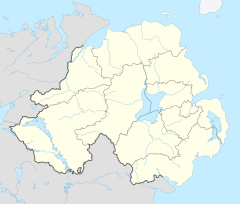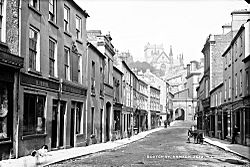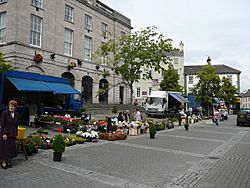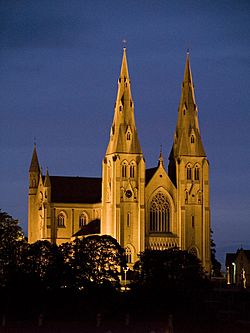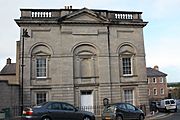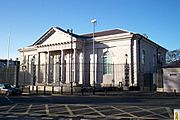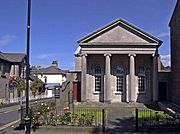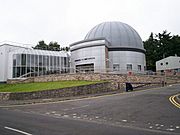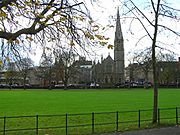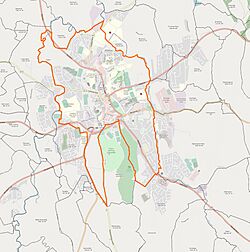Armagh facts for kids
Quick facts for kids Armagh
|
|
|---|---|
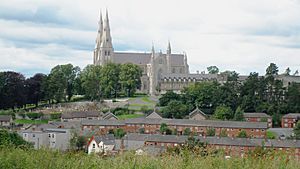 St Patrick's Cathedral, Armagh |
|
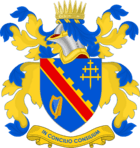 |
|
| Population | 16,310 (2021 Census) |
| Irish grid reference | H876455 |
| • Belfast | 33 mi (53 km) |
| District |
|
| County | |
| Country | Northern Ireland |
| Sovereign state | United Kingdom |
| Post town | ARMAGH |
| Postcode district | BT60, BT61 |
| Dialling code | 028 |
| EU Parliament | Northern Ireland |
| UK Parliament |
|
| NI Assembly |
|
| Website | armagh.gov.uk |
Armagh (pronounced ar-MAH) is a city in Northern Ireland. It is the main town of County Armagh. This city is very important for churches in Ireland. It is home to the main leaders (Archbishops) for both the Roman Catholic Church and the Church of Ireland.
Long ago, a place nearby called Navan Fort was a special site for ancient Irish people. Today, Armagh has two cathedrals, both named after Saint Patrick. It also has the Armagh Observatory, a place where people study stars. Armagh is also famous for its beautiful old buildings from the Georgian era.
Even though it's called a city, Armagh is statistically a medium-sized town. It officially became a city in 1994. In 2021, about 16,310 people lived there.
Contents
History of Armagh

How Armagh Started
Near Armagh, there was an ancient site called Eamhain Mhacha (Navan Fort). It was a special place for pagan rituals and a capital city for the ancient kingdom of Ulster. This site was mostly left empty after the 1st century.
Later, in the 3rd century, a circular ditch was dug around Cathedral Hill. This area is now the heart of Armagh. It was also a pagan holy place, named Ard Mhacha, meaning "Macha's height," after a goddess. This name later became "Armagh."
When Christianity came to Ireland, this pagan site became a Christian one. Tradition says that Saint Patrick built his main church here in 445 AD. This church became the most important church in Ireland.
Armagh in Medieval Times
By the 7th century, Armagh was a very important center for churches, monasteries, and schools in northern Ireland. A famous book called the Book of Armagh was written here in the early 800s. It contains some of the oldest writings in the Old Irish language.
Armagh was attacked by Vikings many times starting in 832 AD. Despite the raids, the city continued to be important.
In 1004, Brian Boru, a famous High King of Ireland, visited Armagh. He gave a lot of gold to the church, showing how important it was. After he died in battle in 1014, Brian Boru was buried at Armagh cathedral.
Later, in 1171, a meeting in Armagh decided that all English people who were enslaved in Ireland should be set free.
Armagh in Later Years
During the 1500s, Armagh was often caught in fights between the English and the O'Neill family. The town was important because it was between English-controlled areas and the O'Neill lands. It changed hands many times and was often destroyed.
After these wars, English rule became stronger in Armagh. The cathedral came under the control of the Protestant Church of Ireland. People from Britain also began to settle in the town.
During the Irish Rebellion of 1641, many British settlers went to Armagh cathedral for safety. Later, Catholic rebels took over the town and set fire to it.
Modern Armagh
Armagh has always been a place for learning. It is sometimes called "the city of saints and scholars." The Royal School was founded in 1608. Armagh Observatory, where people study space, was started in 1790.
In the 1900s, Armagh saw some difficult times. During World War I, three brothers from Armagh died in the Battle of the Somme.
During the Irish War of Independence, an officer was killed in Armagh in 1921. Later that year, important Irish leaders spoke to a large crowd of 10,000 people in Armagh.
During a period known as the Troubles in Armagh, from 1969 to 1994, there was a lot of violence. Sadly, 86 people died in Armagh and nearby areas during this time. The Armagh City Hall was badly damaged by a bomb in 1972 and later torn down.
City Status
Armagh has been seen as a city for a very long time, even before official rules for city status existed. It was officially recognized as a borough in 1613. However, it lost its city status in 1840 when its local government was changed.
For many years, Armagh tried to get its city status back. In 1994, Queen Elizabeth II personally asked for Armagh to be given city status again. This was to celebrate 1,550 years since Saint Patrick was said to have founded the city. It also recognized Armagh's important Christian history.
The official document giving Armagh city status was given to the local council in 1995. The council then changed its name to Armagh City and District Council. Today, the Armagh City, Banbridge and Craigavon Borough Council looks after the city. Armagh has the smallest population of all the cities in Northern Ireland.
Notable Buildings
Armagh is special because it has two cathedrals, both named after Saint Patrick, and both are on hills. The Church of Ireland cathedral is very old, dating back to about 445 AD. The Roman Catholic cathedral was built in the late 1800s. It has two tall spires that are 64 meters (210 feet) high.
Armagh also has many beautiful buildings from the Georgian period. One well-known building is the former women's prison, Armagh Gaol. It was built starting in 1780. Most of its working life, it was a prison for women. It closed in 1986.
The city is home to the Armagh Observatory, which opened in 1790. The Armagh Planetarium was built in 1968 to help people learn about space. The Archbishop's Palace, where the Archbishop of Armagh used to live, is now the local council offices. You can also visit the Palace Stables heritage center, which shows what the old stables looked like.
The Armagh Public Library on Abbey Street is another important building. It was started in 1771 by Archbishop Richard Robinson. It has many old books, including a copy of Gulliver's Travels that belonged to Dean Jonathan Swift.
The Armagh Market House, built in 1815, is now used as a library. The Armagh County Museum is the oldest county museum in Ireland. It opened in 1937 and was originally a school.
Townlands
Armagh is part of a larger area called the civil parish of Armagh. This parish is divided into smaller areas called townlands. The names of these townlands often come from the Irish language. When new buildings were put up, the streets and housing areas often took their names from these old townlands.
In 1830, many of Armagh's townlands were joined together for easier management. They were called Corporation Lands. The townlands outside this area stayed separate. Here are some of them and what their names might mean:
- Aghamoat (from Irish for "Mochta's field")
- Ballynahone More (from Irish for "townland of the river")
- Cargagh (from Irish for "rocky land")
- Cavanacaw (from Irish for "hollow of the battle" or "hollow of the chaff")
- Drumadd (from Irish for "O'Keenan's ridge")
- Drumarg (from Irish for "ridge of the boundary")
- Drumman More (from Irish for "the ridge")
- Killuney (from Irish for "Liamhain's church")
- Legarhill or Mullaghcreevie (from Irish for "hilltop of the branch")
- Longstone (named after a tall standing stone)
- Lurgyvallen (from Irish for "O'Mallon's long low ridge")
- Mullynure (from Irish for "hilltop of the yew")
- Parkmore (from Irish for "great field")
- Tullyelmer (possibly from Irish for "hillock of the yellow clay")
- Umgola (from Irish for "hill-shoulder")
People of Armagh (Demography)
| National Identity of Armagh residents (2021) | ||||
|---|---|---|---|---|
| Nationality | Per cent | |||
| Irish | 47.9% | |||
| Northern Irish | 24.1% | |||
| British | 20.2% | |||
2021 Census Information
On March 21, 2021, there were 16,310 people living in Armagh. Here's a quick look at who they are:
- About 22% were under 16 years old.
- About 62% were between 16 and 65 years old.
- About 15% were 66 years or older.
- More than half (51.9%) of the people living there were female.
- About 67% were Catholic or grew up Catholic.
- About 24% were Protestant or grew up Protestant.
- About 48% said they had an Irish national identity.
- About 20% said they had a British national identity.
- About 24% said they had a Northern Irish national identity. (People could choose more than one identity).
- About 21% knew some Irish (Gaeilge).
- About 5% knew some Ulster Scots.
Governance
Until 2015, Armagh had its own local council called Armagh City and District Council. Then, it joined with two other councils to form the Armagh City, Banbridge and Craigavon Borough Council. This is sometimes called the ABC council.
Armagh is part of the Newry and Armagh Assembly constituency. This means people in Armagh vote for representatives in the Northern Ireland Assembly and the Westminster Parliament in London.
Administration
Armagh is an important center for administration. The main offices for the Education Authority (Southern) and the Southern Health and Social Care Trust are located here.
The North/South Ministerial Council also has its office in Armagh. This council helps Northern Ireland and the Republic of Ireland work together.
Armagh is also where the leaders of both the Church of Ireland Archbishop of Armagh and the Roman Catholic Archbishop of Armagh are based. They are both known as the Primate of All Ireland for their churches.
Education
Armagh has many schools for different age groups.
Primary Schools
- Armstrong Primary School
- Christian Brothers Primary School Armagh
- The Drelincourt Primary School
- Dromintee Primary School
- Drumhillery Primary School
- Mount St Catherine's Primary School
- The Royal School Preparatory School
- Saints and Scholars Integrated Primary School
- St. Malachy's Primary School
- St. Patrick's Primary School
Post-primary Schools (High Schools and Colleges)
- City of Armagh High School
- St. Catherine's College, Armagh
- St. Patrick's Grammar School, Armagh
- The Royal School, Armagh
- Southern Regional College
Transport
In the past, Armagh was connected by railway lines to other cities like Belfast and Monaghan. However, a terrible train accident happened near Armagh in 1889, killing 80 people.
After Ireland was divided in 1922, many railway lines closed. By 1957, all train services to Armagh had stopped.
Today, Armagh is the only city in Ireland without a train station. The closest station is in Portadown. From there, you can take trains to Belfast or to Dublin. There have been talks about bringing the railway back to Armagh.
Sport
Armagh has many sports clubs for different interests:
- Armagh City Football Club is the main soccer team.
- City of Armagh Rugby Club is the local rugby team.
- Lisanally Rangers F.C. is another local soccer team.
- For Gaelic football, there are Armagh Harps and Pearse Ógs.
- The local GAA handball club is Eugene Quinn's.
- The local hurling club is Armagh Cúchulainns.
In 2004, the Royal School, Armagh made history by winning both the schools' rugby and hockey cups in the same year.
The Mall in Armagh is a famous place for cricket. It is where the Armagh Cricket Club is located.
Armagh Athletics Club, started in 1969, organizes the yearly Armagh International 5k Road Race. This race first took place in 1980.
Notable People
Many interesting people were born or lived in Armagh:
- Tom Boyd (born 1888), a professional golfer.
- Daragh Carville (born 1969), a playwright and screenwriter.
- David Cunningham (born 1954), a musician.
- Moses Harvey (born 1820), a clergyman and naturalist who studied giant squid.
- John Lennox (born 1943), a mathematician and philosopher.
- Patrick Magee (born 1922), an actor and director.
- Saint Malachy (born 1094), a famous saint.
- Seamus McGarvey (born 1967), an award-nominated cinematographer.
- Colin Morgan (born 1986), an actor known for playing Merlin.
- Ian Paisley (born 1926), a politician and former First Minister of Northern Ireland.
- Thomas Romney Robinson (1792–1882), an astronomer.
- Christopher Vokes (born 1904), a Major General.
- William Whitford (1846–1930), a physician.
- Charles Wood (born 1866), a composer.
Climate
Armagh has a mild, wet climate. The Armagh Observatory has been collecting weather data since 1794. The coldest temperature ever recorded was -15.0°C (5.0°F) in February 1895. The warmest daily low temperature was 20.6°C (69.1°F) in July 1868.
| Climate data for Armagh, elevation: 42 m (138 ft), 1991–2020 normals, extremes 1844–present | |||||||||||||
|---|---|---|---|---|---|---|---|---|---|---|---|---|---|
| Month | Jan | Feb | Mar | Apr | May | Jun | Jul | Aug | Sep | Oct | Nov | Dec | Year |
| Record high °C (°F) | 15.7 (60.3) |
17.1 (62.8) |
21.8 (71.2) |
22.6 (72.7) |
26.2 (79.2) |
30.4 (86.7) |
31.4 (88.5) |
29.4 (84.9) |
27.6 (81.7) |
22.7 (72.9) |
16.8 (62.2) |
16.6 (61.9) |
31.4 (88.5) |
| Mean daily maximum °C (°F) | 7.8 (46.0) |
8.6 (47.5) |
10.4 (50.7) |
13.0 (55.4) |
15.8 (60.4) |
18.2 (64.8) |
19.7 (67.5) |
19.4 (66.9) |
17.3 (63.1) |
13.7 (56.7) |
10.3 (50.5) |
8.0 (46.4) |
13.5 (56.3) |
| Mean daily minimum °C (°F) | 2.2 (36.0) |
2.0 (35.6) |
3.1 (37.6) |
4.6 (40.3) |
7.0 (44.6) |
9.9 (49.8) |
11.8 (53.2) |
11.6 (52.9) |
9.7 (49.5) |
7.0 (44.6) |
4.3 (39.7) |
2.4 (36.3) |
6.3 (43.3) |
| Record low °C (°F) | −14.3 (6.3) |
−15.0 (5.0) |
−12.4 (9.7) |
−7.1 (19.2) |
−2.3 (27.9) |
0.8 (33.4) |
0.0 (32.0) |
2.3 (36.1) |
−0.6 (30.9) |
−5.6 (21.9) |
−8.3 (17.1) |
−14.6 (5.7) |
−15.0 (5.0) |
| Average rainfall mm (inches) | 72.7 (2.86) |
58.8 (2.31) |
59.7 (2.35) |
55.7 (2.19) |
58.0 (2.28) |
62.8 (2.47) |
69.3 (2.73) |
78.2 (3.08) |
65.1 (2.56) |
81.0 (3.19) |
81.8 (3.22) |
80.9 (3.19) |
824 (32.43) |
| Average rainy days (≥ 1.0 mm) | 14.0 | 12.2 | 12.1 | 11.5 | 12.0 | 11.6 | 12.5 | 13.0 | 11.2 | 12.8 | 14.3 | 14.3 | 151.5 |
| Mean monthly sunshine hours | 47.2 | 70.8 | 101.5 | 150.0 | 180.0 | 144.8 | 134.7 | 140.2 | 114.2 | 92.2 | 61.6 | 43.0 | 1,280.2 |
| Source 1: Met Office | |||||||||||||
| Source 2: AOMD Belfast Telegraph (July record high) | |||||||||||||
Images for kids
See also
 In Spanish: Armagh para niños
In Spanish: Armagh para niños


